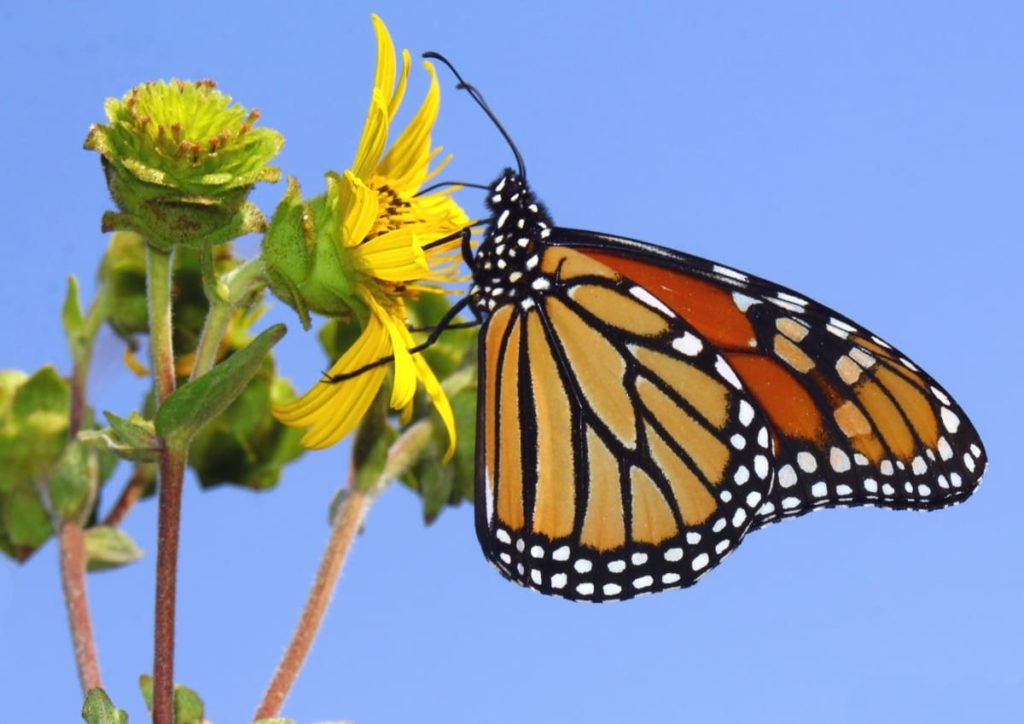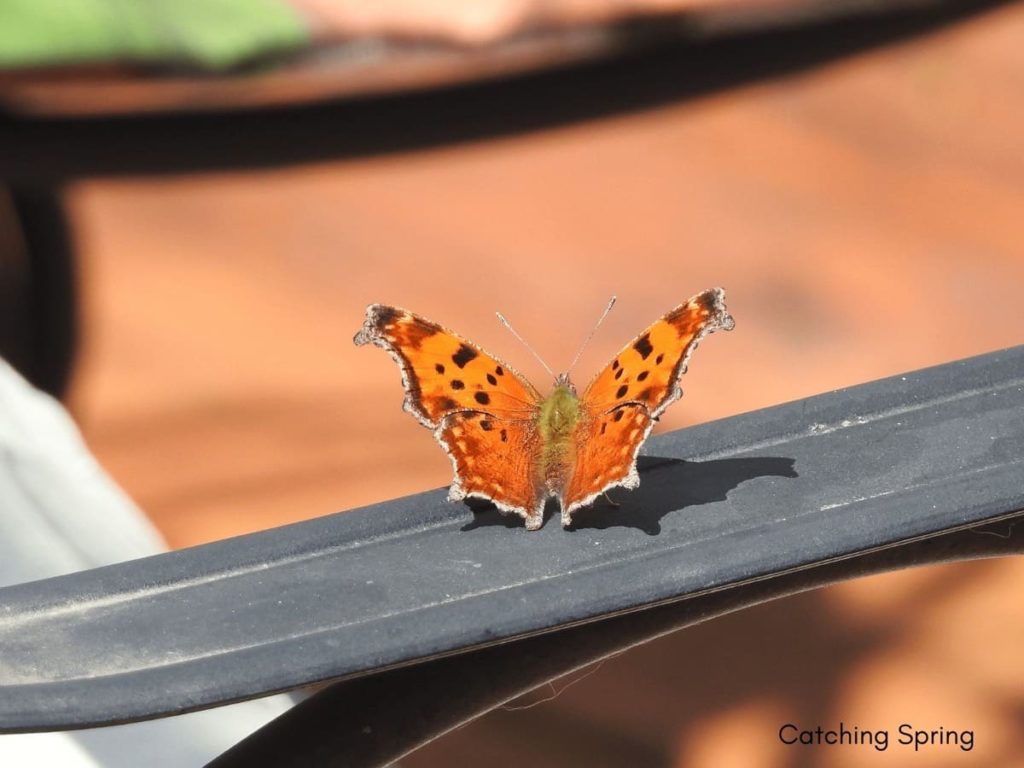I like to call them flying jewels or flowers with wings. Butterflies add beauty and wonder to any garden. Having host plants for them to lay eggs makes it even better. Here are 50 to get you started.
Over 60 Host Plants for Attracting Beautiful Butterflies to Your Yard!
Think of your yard as the whole picture for the beautiful butterflies that wander into it.
You don’t just want to offer host plants, but nectar flowers as well. Then, not only will you see these flying jewels, but also the incredible beauty that flowers add.
Some might think I have too many flowers in my yard. I say there is no such thing. 🙂 Add those host plants, and you’ll be constantly entertained and amazed at the cycle of life.
Plus, you’ll no doubt attract countless other pollinators, hummingbirds, and other pretty birds into your yard.
The most significant benefit will be helping bees and other pollinators thrive! Let’s dig in, and please note that I will separate each category of host plants by the butterfly host itself.
1. Monarchs

This will be a short paragraph because Monarchs only have one host plant, milkweed. Without it, there would be no Monarchs.
So without going into best practices and how you can help this iconic butterfly, I will suggest you find out which milkweed plants are native to your area and plant plant plant!
Here are some varieties of milkweed to get you started on your search:
- Common
- Prairie
- Swamp
- Whorled
- Showy
- Narrowleaf
- Tropical
- Butterfly Weed
- Hairy Balls (yes seriously)
- And more!
Bring back the Monarch! They are such a joy to see in our gardens!
2. American Lady

These butterflies are so pretty! Of course, all of them are. But if you want to not only see them in your yard but see them raise families, plant their host plants.
The following are some of plants the American Lady uses:
- Asters
- Pussy Toes
- Ironweed
- Pearly Everlasting
- Sweet Everlasting
- Silver Brocade
- Anise
- And more!
3. Painted Lady

I love seeing these on my flowers; they look delicately painted inside and outside their wings! Although similar in appearance to the American Lady, the difference can be seen on the underside of their hind wings.
The American Lady has two large “eyespots,” and the Painted Lady has four. I see the Painted Lady more here as they readily come to my flower gardens. I’ll also see them flying in my pastures on the wildflowers.
To give them their host plants, try these common ones:
- Sunflowers
- Shasta Daisy
- Thistles
- Hollyhocks
- Mallow
- Plantain
- Legumes
4. Common Buckeye

These butterflies are so cool-looking! I don’t see them as often in my flower gardens as I see them flitting around the wildflowers in my pastures and fields! Their “eyespots” on their wings give them away!
Some common host plants include:
- Snapdragons
- Sedum
- Plantains
- Ruellia
- False Foxglove
- Monkey flowers
- Gerardia
- Hoary Vervain
- And others
I planted Snapdragons for the first time this year (I know, what was I waiting for!?). How fun would that be to host this pretty butterfly? 🙂
5. Swallowtails

There are a wide variety of gorgeous Swallowtail butterflies and a wide variety of host plants, depending on the species. I went in-depth with Swallowtail host plants in another article, but here is a shortlist of the common host plants for the more common Swallowtails:
- Dill
- Parsley
- Rue
- Prickly Ash
- Pipevines
- Spicebush
- Fennel
- Carrots
- Ash trees
- Willows
- Cottonwoods
- Wild Black Cherry trees
- Paw Paw trees
- Sassafrass trees
- And more!
These are some of the largest butterflies in North America, and so beautiful, too! I so love seeing them!
6. Cabbage White

Cabbage Whites are some of the most popular butterflies you’ll see. These smaller-sized white butterflies seem to be flying around everywhere in the summer. If you look closely at them, you’ll see how pretty they are!
Some of their host plants include:
- Broccoli
- Cauliflower
- A variety of Mustards
- Cabbage
- London Rocket
- And more!
Unfortunately, as you see, their host plants are probably most of what you grow to feed your family. But they seem to do well on their host weeds as well since there are so many!
7. Mourning Cloak

These handsome butterflies weren’t as common around here until this year. I seem to have seen a lot of them this summer so far! They are so pretty and will often hang out at the edge of woods and fields. Or, as this year proves, on my Common Milkweed flowers!
Some of their favorite host plants include:
- Willow
- Elm
- Cottonwoods
- Birch
- Hawthorne
- Mulberry
- Hackberry
- Shasta Daisy
- And more!
This is why you see them so often near trees – it’s the major portion of their host plant!
8. Milbert’s Tortoiseshell

This little beauty is more of a rarity, yet I’ve seen them almost more than any other butterfly so far this year. So strange, but so great! Their jerky little movements can single them out as this species if you see them flying around or exercising their wings on a plant.
I must have a lot of their host plants here this year, which include:
- Nettles
Yep, that’s pretty much it. Thankfully, it also includes False Nettle, which does not have the regular nettles’ stinging ability. They love my flower gardens and horse barn!
9. Red Admiral

Another beautiful butterfly that’s fun to see around, the Red Admiral. I don’t see these as often, but I see them either on my flowers or in my fields.
Like the Milbert’s Tortoiseshell, their host plants are:
- Nettles
- Shasta Daisy
I’ve accidentally gotten “stung” by Stinging Nettles, so be careful if you see those plants! I opt for planting False Nettles!
10. Viceroy

The smartness of this pretty butterfly comes from the near-identical markings of the Monarch. Most of nature knows that Monarchs don’t taste very good or are even a little toxic due to their ingestion of milkweed.
Yet, the Viceroy’s host plants are quite different from that of a Monarch. They are:
- Cottonwoods
- Willows
- Aspen
- Cherry
- Apple
- Plum
You can notice if it’s a Viceroy you’re looking at by the black line going across the hind wings. The Monarch doesn’t have that.
11. Hairstreaks

There are quite a few different kinds of Hairstreak butterflies, including the gray, brown, and black. The Gray Hairstreaks are the ones I see here most often. They are small but beautiful butterflies!
Their host plants include:
- Clovers
- Mallows
- Buckwheats
- Members of the pea family
- And more
12. Silver-spotted Skipper

While there is a large variety of Skipper butterflies, I will list the Silver-spotted Skipper here, as that’s the one I see most often in my flower gardens. I’ve also seen the gorgeous Duskywinged Skipper, but not as common.
Host plants for Skippers include:
- Black Locust
- Panicled Tick Trefoil
- Several species of legumes
13. Great Spangled Fritillary

I love the Fritillary butterflies; they are so pretty! There are a few different varieties of Fritillary, but this is the one I see most here. I’ve also seen the Variegated Fritillary, I believe! 🙂
Their host plants are simple:
- Different kinds of Violets
They actually overwinter as caterpillars and eat the young violet leaves when they emerge! They are gorgeous butterflies!
14. Red Spotted Purple (or Admiral)

These are some gorgeous butterflies! I often see them in my flower gardens or hummingbird feeders, and I love seeing them! They usually prefer tree sap, animal dung (like many butterflies!), and rotting fruit, though.
This is another butterfly whose host plants mostly consist of trees. They are:
- Willow
- Wild Cherry
- Cottonwood
- Black Oak
- Hawthorne
- And other trees
15. Baltimore Checkerspot

I love this small yet colorful butterfly and often see them in my fields and pasture. They have a lot of intricate markings on their small wings!
Their main host plant is:
- White Turtlehead
Once the caterpillars get a little bigger, their secondary host plants may include:
- Honeysuckle
- Penstemon
- Plantains
- Viburnums
- Ash trees
16. Sulfurs

There are also quite a few different Sulfur butterfly varieties. The common ones include the Orange and Cloudless Sulfurs. They are pretty butterflies that are often seen flying over meadows and fields.
Common host plants include:
- Baptisia
- Senna
- Other pea family plants
Often people think that hummingbirds are attracted to red. And while this really isn’t the case, these butterflies are. They are so attracted to red that they are often seen flying into the red taillights on cars! So plant red flowers in addition to your flower garden to attract the adults.
17. Eastern Commas

The Eastern Comma is such a pretty butterfly, and I wish I saw them more often around here! I’ll see a few a year if that! When I do see them, they are often on my milkweed flowers or my butterfly bush.
Here are their host plants:
- False Nettle
- Other Nettles
- Hop vines
- Elm trees
The outside of their wings looks exactly like a dried leaf. And if you look closely, you’ll see what looks like a white comma on the outside of the hind wing.
18. Question Mark

Looking almost identical to the Eastern Comma is this beautiful orange butterfly with a question mark on the outside of the wings in place of the Eastern Comma’s comma. The outside of their wings also resembles a dried-up leaf!
The host plants of the Question Mark are:
- American and red elms
- Hackberry
- Hops
- False Nettle
- Other Nettles
I know there are many, many other butterflies in this world of ours! This list would be pages long if I continued. For instance, the beautiful Pearl Crescent likes Asters; the Silvery Checkerspot likes Black-eyed Susans, Sunflowers, and Coneflowers, and many Skippers love Little Bluestem grass.
The small but beautiful Spring Azure uses the Flowering Dogwood as its host plant, and the Chalcedon Checkerspot uses the Indian Paintbrush. So many beautiful flowers, shrubs, and trees we can plant to help support our pollinators and treat our eyes!
What are you going to plant to help the butterfly and pollinator population? Would you mind sharing with me and commenting below? 🙂
Leave a Reply